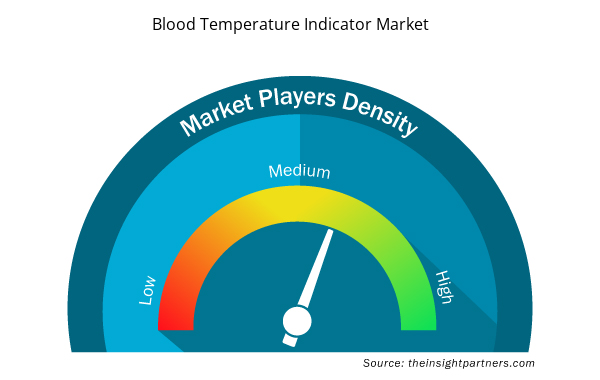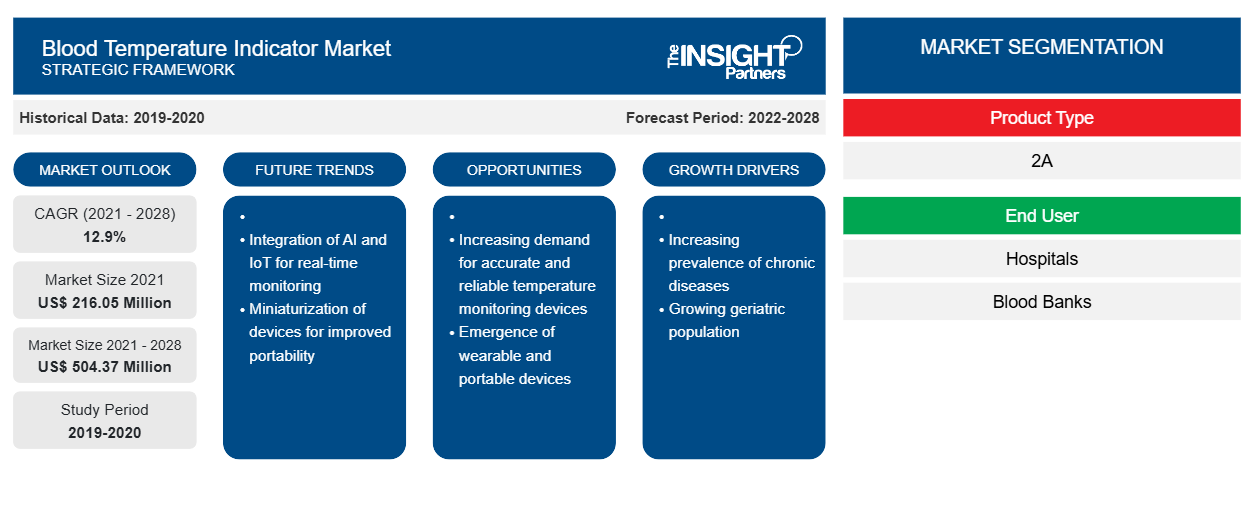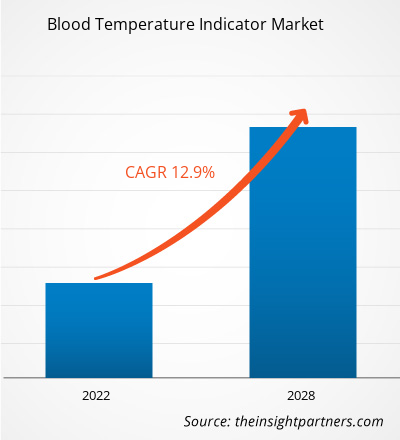من المتوقع أن ينمو سوق مؤشر درجة حرارة الدم من 216.05 مليون دولار أمريكي في عام 2021 إلى 504.37 مليون دولار أمريكي بحلول عام 2028؛ ومن المتوقع أن يسجل معدل نمو سنوي مركب بنسبة 12.9٪ من عام 2021 إلى عام 2028.
مؤشرات درجة حرارة الدم هي أجهزة طبية صغيرة أو حلول تساعد على زيادة سلامة الدم من خلال نقل الدم ومكونات الدم بشكل فعال وكفء. توفر هذه المؤشرات دليلاً قابلاً للتدقيق على تخزين الدم ونقله وفقًا للمعايير التنظيمية، مما يقلل بشكل أكبر من هدر الدم.
يقدم التقرير رؤى وتحليلات متعمقة لسوق مؤشر درجة حرارة الدم ، مع التركيز على معايير مختلفة مثل اتجاهات السوق والتقدم التكنولوجي وديناميكيات السوق. كما يوفر تحليلًا للمنافسة بين كبار اللاعبين في السوق وتأثير جائحة COVID-19 على سوق مؤشر درجة حرارة الدم في جميع المناطق الرئيسية. لقد أحدث وباء COVID-19 اضطرابًا في الظروف الاجتماعية والاقتصادية لمختلف البلدان في جميع أنحاء العالم. وفقًا لإحصاءات منظمة الصحة العالمية لعام 2021، فإن الولايات المتحدة هي الدولة الأكثر تضررًا في العالم بسبب جائحة COVID-19، مع أعلى عدد من حالات COVID-19. أعاق العدد المرتفع من الحالات اقتصاد أمريكا الشمالية، وخاصة الولايات المتحدة. أدى وباء COVID-19 إلى تغييرات تكنولوجية حاسمة لتوفير رعاية طبية أفضل. بسبب انتشار فيروس SARS-CoV-2، يتم إغلاق العديد من المدن، مما أدى إلى إلغاء العلاج من قبل الأطباء / الجراحين. أثر وباء COVID-19 على تصنيع وتوريد مؤشرات درجة حرارة الدم بسبب الاضطراب في سلسلة التوريد على مستوى العالم. بالإضافة إلى ذلك، يقوم العاملون في مجال الرعاية الصحية بإعطاء الأولوية لإجراءات الطوارئ وإلغاء جميع العمليات الجراحية الاختيارية لمنع انتشار فيروس كورونا.
في عام 2020، سمحت إدارة الغذاء والدواء (FDA) بالاستخدام الطارئ لبلازما النقاهة لعلاج مرضى كوفيد-19، مما أدى إلى زيادة التبرع بالدم. علاوة على ذلك، من المتوقع أن يدعم وجود كبار اللاعبين في السوق وتعاونهم الاستراتيجي المتنوع في سوق مؤشر درجة حرارة الدم نمو السوق. على سبيل المثال، أطلقت شركة Timestrip، مطورة تقنية المؤشر الذكي، مجموعة جديدة تمامًا بمؤشرين إلكترونيين لدرجة الحرارة. ستكون هذه المؤشرات بالغة الأهمية في مراقبة التخزين والنقل الآمن للسلع المختلفة، بما في ذلك الأدوية واللقاحات والرعاية الصحية والمنتجات الغذائية والمواد اللاصقة والحبر. وبالتالي، أثر جائحة كوفيد-19 سلبًا على سوق مؤشر درجة حرارة الدم.
استنادًا إلى المنطقة، يتم تقسيم سوق مؤشر درجة حرارة الدم إلى أمريكا الشمالية وأوروبا ومنطقة آسيا والمحيط الهادئ والشرق الأوسط وأفريقيا وأمريكا الجنوبية والوسطى.
قم بتخصيص هذا التقرير ليناسب متطلباتك
ستحصل على تخصيص لأي تقرير - مجانًا - بما في ذلك أجزاء من هذا التقرير، أو تحليل على مستوى الدولة، وحزمة بيانات Excel، بالإضافة إلى الاستفادة من العروض والخصومات الرائعة للشركات الناشئة والجامعات
- احصل على أهم اتجاهات السوق الرئيسية لهذا التقرير.ستتضمن هذه العينة المجانية تحليلاً للبيانات، بدءًا من اتجاهات السوق وحتى التقديرات والتوقعات.
رؤى السوق
زيادة عمليات نقل الدم والتبرع به تدفع سوق مؤشر درجة حرارة الدم إلى الارتفاع
نقل الدم هو أحد الإجراءات الشائعة الاستخدام في الرعاية الصحية، والذي يساعد في الحفاظ على مستوى الدم لدى المرضى. هناك العديد من الحالات المزمنة والإجراءات الجراحية وحالات الصدمات التي تتطلب نقل الدم حتى يتمكن المرضى من البقاء على قيد الحياة دون أي آثار جانبية بسبب انخفاض مستويات الدم. تؤدي الحالات الطبية، بما في ذلك الثلاسيميا وسرطان الدم وفقر الدم المنجلي وفقر الدم والحالات الجراحية والصدمات، إلى فقدان الدم وتتطلب نقل الدم. وفقًا لمنظمة الصليب الأحمر الأمريكية، يتم نقل حوالي 16 مليون مكون دم كل عام في الولايات المتحدة. علاوة على ذلك، يؤثر فقر الدم المنجلي على 90.000-100.000 شخص في الولايات المتحدة؛ يولد حوالي 1000 طفل بهذا المرض كل عام. وبالتالي، أدى الانتشار المتزايد للأمراض المزمنة إلى خلق الطلب على نقل الدم، والذي من المتوقع أن يدفع نمو سوق مؤشر درجة حرارة الدم.
بعد جمع الدم، يجب تخزينه ونقله في ظل ظروف ودرجات حرارة محددة. إذا تم تخزين الدم ونقله خارج نطاق درجة الحرارة المحددة لفترة طويلة، فإنه يفقد قدرته على حمل الأكسجين، مما قد يسبب مشاكل خطيرة. علاوة على ذلك، هناك خطر التلوث البكتيري الشديد إذا تعرض الدم لدرجات حرارة دافئة. تلعب مؤشرات درجة حرارة الدم دورًا مهمًا في الحفاظ على الظروف ودرجة الحرارة المطلوبة للنقل الآمن والموثوق للدم ومكوناته. إنه يقلل من فرص تلف الدم من خلال مراقبة درجة الحرارة عن كثب والحفاظ على سلامة الدم أثناء النقل. وبالتالي، فإن زيادة نقل الدم والتبرع بالدم والطلب المتزايد على النقل الآمن للدم ومكوناته يخلق طلبًا على مؤشرات درجة حرارة الدم، مما يدفع نمو السوق.
رؤى تعتمد على نوع المنتج
بناءً على نوع المنتج، يتم تقسيم سوق مؤشر درجة حرارة الدم إلى 2 درجة مئوية إلى 4 درجات مئوية، و5 درجات مئوية إلى 7 درجات مئوية، وأعلى من 7 درجات مئوية. في عام 2021، استحوذت شريحة 2 درجة مئوية إلى 4 درجات مئوية على أكبر حصة سوقية. وقد زاد وضع هذا القطاع في السوق بسبب استخدامه الرئيسي أثناء نقل الدم على طول الطريق. على سبيل المثال، وفقًا للمبادئ التوجيهية الأوروبية والأمريكية الرئيسية، يجب أن تتراوح درجة حرارة أكياس خلايا الدم الحمراء من 1 درجة مئوية إلى 6 درجات مئوية أثناء تخزينها، ومن 1 درجة مئوية إلى 10 درجات مئوية أثناء الحمل.
رؤى إقليمية حول سوق مؤشر درجة حرارة الدم
لقد قام المحللون في Insight Partners بشرح الاتجاهات والعوامل الإقليمية المؤثرة على سوق مؤشر درجة حرارة الدم طوال فترة التنبؤ بشكل شامل. يناقش هذا القسم أيضًا قطاعات سوق مؤشر درجة حرارة الدم والجغرافيا في جميع أنحاء أمريكا الشمالية وأوروبا ومنطقة آسيا والمحيط الهادئ والشرق الأوسط وأفريقيا وأمريكا الجنوبية والوسطى.

- احصل على البيانات الإقليمية المحددة لسوق مؤشر درجة حرارة الدم
نطاق تقرير سوق مؤشر درجة حرارة الدم
| سمة التقرير | تفاصيل |
|---|---|
| حجم السوق في عام 2021 | 216.05 مليون دولار أمريكي |
| حجم السوق بحلول عام 2028 | 504.37 مليون دولار أمريكي |
| معدل النمو السنوي المركب العالمي (2021 - 2028) | 12.9% |
| البيانات التاريخية | 2019-2020 |
| فترة التنبؤ | 2022-2028 |
| القطاعات المغطاة | حسب نوع المنتج
|
| المناطق والدول المغطاة | أمريكا الشمالية
|
| قادة السوق وملفات تعريف الشركات الرئيسية |
|
كثافة اللاعبين في سوق مؤشر درجة حرارة الدم: فهم تأثيرها على ديناميكيات الأعمال
يشهد سوق مؤشر درجة حرارة الدم نموًا سريعًا، مدفوعًا بالطلب المتزايد من المستخدم النهائي بسبب عوامل مثل تفضيلات المستهلك المتطورة والتقدم التكنولوجي والوعي المتزايد بفوائد المنتج. ومع ارتفاع الطلب، تعمل الشركات على توسيع عروضها والابتكار لتلبية احتياجات المستهلكين والاستفادة من الاتجاهات الناشئة، مما يؤدي إلى زيادة نمو السوق.
تشير كثافة اللاعبين في السوق إلى توزيع الشركات أو المؤسسات العاملة في سوق أو صناعة معينة. وهي تشير إلى عدد المنافسين (اللاعبين في السوق) الموجودين في مساحة سوق معينة نسبة إلى حجمها أو قيمتها السوقية الإجمالية.
الشركات الرئيسية العاملة في سوق مؤشر درجة حرارة الدم هي:
- ايليتيش
- شركة ثيرمو فيشر العلمية
- سيركاليا
- مجموعة ايلاب
- شركة زيبرا تكنولوجيز
إخلاء المسؤولية : الشركات المذكورة أعلاه ليست مرتبة بأي ترتيب معين.

- احصل على نظرة عامة على أهم اللاعبين الرئيسيين في سوق مؤشر درجة حرارة الدم
رؤى المستخدم النهائي
بناءً على المستخدم النهائي، يتم تقسيم سوق مؤشر درجة حرارة الدم إلى المستشفيات وبنوك الدم وغيرها. سيطر قطاع المستشفيات على السوق في عام 2021.
يتبنى اللاعبون في سوق مؤشر درجة حرارة الدم استراتيجيات عضوية مثل إطلاق المنتج وتوسيعه لتوسيع بصمتهم ومحفظة منتجاتهم على مستوى العالم.
نبذة عن الشركة
- ايليتيش
- شركة ثيرو فيشر العلمية
- سيركاليا
- مجموعة ايلاب
- شركة زيبرا تكنولوجيز
- ليزالين لتقنيات علوم الحياة
- شركة ستريم بيك الدولية المحدودة
- 3م
- شركة دلتا تراك
- تايم ستريب المملكة المتحدة المحدودة
- التحليل التاريخي (سنتان)، السنة الأساسية، التوقعات (7 سنوات) مع معدل النمو السنوي المركب
- تحليل PEST و SWOT
- حجم السوق والقيمة / الحجم - عالميًا وإقليميًا وقطريًا
- الصناعة والمنافسة
- مجموعة بيانات Excel



Report Coverage
Revenue forecast, Company Analysis, Industry landscape, Growth factors, and Trends

Segment Covered
This text is related
to segments covered.

Regional Scope
North America, Europe, Asia Pacific, Middle East & Africa, South & Central America

Country Scope
This text is related
to country scope.
الأسئلة الشائعة
Global blood temperature indicator market is segmented by region into North America, Europe, Asia Pacific, Middle East & Africa, and South & Central America. In North America, the U.S. is the largest market for blood temperature indicator market. The US is estimated to hold the largest share in the blood temperature indicator market during the forecast period. The presence of top players and increased demand for blood transfusion are the contributing factors for the regional growth. Additionally, improvements in healthcare infrastructure, increase in blood banks, high adoption rate and increased awareness among people regarding blood donation are the key factor responsible for the Asia-Pacific regional growth for blood temperature indicator accounting fastest growth of the region during the coming years.
Elitech; Thermo Fisher Scientific Inc.; Ellab Group; Zebra Technologies Corporation; LisaLine Lifesciences Technologies; Stream Peak International Pte Ltd.; 3M; TimeStrip UK Ltd. are among the leading companies operating in the global blood temperature indicator market
The hospital segment dominated the global blood temperature indicator market and accounted for the largest revenue of US$ 90.35 Mn in 2021.
Blood Temperature Indicators are small medical devices or solutions which helps in increasing the blood safety and allows effective and efficient transportation of blood and its components. These indicators provide auditable proof that blood is stored and transported as per regulatory standards this further reduces blood waste.
Increase in blood transportation and donation owing to increasing awareness and rising prevalence of various conditions such as chronic disorders, surgeries trauma cases along with accuracy of blood temperature indicator are the most significant factors responsible for the overall market growth.
Based on product type, 2°C to 4°C segment took the forefront lead in the worldwide market by accounting largest share in 2021 and is expected to continue to do so till the forecast period.
Trends and growth analysis reports related to Life Sciences : READ MORE..
The List of Companies - Blood Temperature Indicator Market
- Elitech
- Thermo Fisher Scientific Inc.
- Sercalia
- Ellab Group
- Zebra Technologies Corporation
- Lisaline Lifesciences Technologies
- Stream Peak International PTE Ltd
- 3M
- DeltaTrak Inc
- TimeStrip UK Ltd
The Insight Partners performs research in 4 major stages: Data Collection & Secondary Research, Primary Research, Data Analysis and Data Triangulation & Final Review.
- Data Collection and Secondary Research:
As a market research and consulting firm operating from a decade, we have published and advised several client across the globe. First step for any study will start with an assessment of currently available data and insights from existing reports. Further, historical and current market information is collected from Investor Presentations, Annual Reports, SEC Filings, etc., and other information related to company’s performance and market positioning are gathered from Paid Databases (Factiva, Hoovers, and Reuters) and various other publications available in public domain.
Several associations trade associates, technical forums, institutes, societies and organization are accessed to gain technical as well as market related insights through their publications such as research papers, blogs and press releases related to the studies are referred to get cues about the market. Further, white papers, journals, magazines, and other news articles published in last 3 years are scrutinized and analyzed to understand the current market trends.
- Primary Research:
The primarily interview analysis comprise of data obtained from industry participants interview and answers to survey questions gathered by in-house primary team.
For primary research, interviews are conducted with industry experts/CEOs/Marketing Managers/VPs/Subject Matter Experts from both demand and supply side to get a 360-degree view of the market. The primary team conducts several interviews based on the complexity of the markets to understand the various market trends and dynamics which makes research more credible and precise.
A typical research interview fulfils the following functions:
- Provides first-hand information on the market size, market trends, growth trends, competitive landscape, and outlook
- Validates and strengthens in-house secondary research findings
- Develops the analysis team’s expertise and market understanding
Primary research involves email interactions and telephone interviews for each market, category, segment, and sub-segment across geographies. The participants who typically take part in such a process include, but are not limited to:
- Industry participants: VPs, business development managers, market intelligence managers and national sales managers
- Outside experts: Valuation experts, research analysts and key opinion leaders specializing in the electronics and semiconductor industry.
Below is the breakup of our primary respondents by company, designation, and region:

Once we receive the confirmation from primary research sources or primary respondents, we finalize the base year market estimation and forecast the data as per the macroeconomic and microeconomic factors assessed during data collection.
- Data Analysis:
Once data is validated through both secondary as well as primary respondents, we finalize the market estimations by hypothesis formulation and factor analysis at regional and country level.
- Macro-Economic Factor Analysis:
We analyse macroeconomic indicators such the gross domestic product (GDP), increase in the demand for goods and services across industries, technological advancement, regional economic growth, governmental policies, the influence of COVID-19, PEST analysis, and other aspects. This analysis aids in setting benchmarks for various nations/regions and approximating market splits. Additionally, the general trend of the aforementioned components aid in determining the market's development possibilities.
- Country Level Data:
Various factors that are especially aligned to the country are taken into account to determine the market size for a certain area and country, including the presence of vendors, such as headquarters and offices, the country's GDP, demand patterns, and industry growth. To comprehend the market dynamics for the nation, a number of growth variables, inhibitors, application areas, and current market trends are researched. The aforementioned elements aid in determining the country's overall market's growth potential.
- Company Profile:
The “Table of Contents” is formulated by listing and analyzing more than 25 - 30 companies operating in the market ecosystem across geographies. However, we profile only 10 companies as a standard practice in our syndicate reports. These 10 companies comprise leading, emerging, and regional players. Nonetheless, our analysis is not restricted to the 10 listed companies, we also analyze other companies present in the market to develop a holistic view and understand the prevailing trends. The “Company Profiles” section in the report covers key facts, business description, products & services, financial information, SWOT analysis, and key developments. The financial information presented is extracted from the annual reports and official documents of the publicly listed companies. Upon collecting the information for the sections of respective companies, we verify them via various primary sources and then compile the data in respective company profiles. The company level information helps us in deriving the base number as well as in forecasting the market size.
- Developing Base Number:
Aggregation of sales statistics (2020-2022) and macro-economic factor, and other secondary and primary research insights are utilized to arrive at base number and related market shares for 2022. The data gaps are identified in this step and relevant market data is analyzed, collected from paid primary interviews or databases. On finalizing the base year market size, forecasts are developed on the basis of macro-economic, industry and market growth factors and company level analysis.
- Data Triangulation and Final Review:
The market findings and base year market size calculations are validated from supply as well as demand side. Demand side validations are based on macro-economic factor analysis and benchmarks for respective regions and countries. In case of supply side validations, revenues of major companies are estimated (in case not available) based on industry benchmark, approximate number of employees, product portfolio, and primary interviews revenues are gathered. Further revenue from target product/service segment is assessed to avoid overshooting of market statistics. In case of heavy deviations between supply and demand side values, all thes steps are repeated to achieve synchronization.
We follow an iterative model, wherein we share our research findings with Subject Matter Experts (SME’s) and Key Opinion Leaders (KOLs) until consensus view of the market is not formulated – this model negates any drastic deviation in the opinions of experts. Only validated and universally acceptable research findings are quoted in our reports.
We have important check points that we use to validate our research findings – which we call – data triangulation, where we validate the information, we generate from secondary sources with primary interviews and then we re-validate with our internal data bases and Subject matter experts. This comprehensive model enables us to deliver high quality, reliable data in shortest possible time.


 احصل على عينة مجانية لهذا التقرير
احصل على عينة مجانية لهذا التقرير